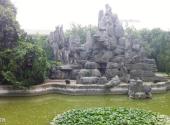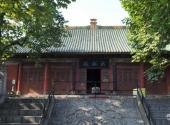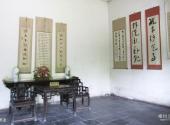
Scenic spot introduction:
The Chunqiu Tower in Xuchang is named after Guan Yu held candles and read "Spring and Autumn" at night. It contains the largest indoor statue of Guan Gong in Asia and is an important tourist attraction on the Three Kingdoms tour route. The Chunqiu Tower was built in the first year of the Yuan Dynasty (AD 1271). It was repaired many times in the Yuan, Ming and Qing dynasties, but was later destroyed by wars and fires, leaving only the Chunqiu Tower. In 1995, the Chunqiu Building was restored, and its scale was the largest in history. Today, it has become a tourist attraction for tourists at home and abroad to visit and worship Guan Gong.Chunqiu Tower is a cultural landscape based on the culture of the Three Kingdoms, with profound cultural connotations and complete infrastructure. The main building on the central axis of the outer courtyard is unique in the architectural style of one-, two-, and three-eaves, and the pavilions, platforms, towers, and pavilions in the inner courtyard are well-proportioned. On the west side, there is a Confucian Temple that is rare in the country and worships both civil and military saints. In addition, the scenic spot also retains many precious inscriptions, among which the "Stele of Li Bin, Longxi County Bo" by the great calligrapher Zhao Mengfu of the Yuan Dynasty is the treasure of the town hall.
Attractions distribution:
Chunqiu Tower is located in the center of Xuchang, in the middle of Confucian Temple Front Street. It is a complex of ancient buildings in the Ming and Qing styles. The existing Chunqiu Tower complex has a basic layout of "one house divided into two courtyards", with three major buildings: Chunqiu Tower, Xuchang Confucian Temple, and Ganmi Second Empress Palace. On the central axis of the outer courtyard are Pheasant Gate, Bell and Drum Tower, Chunqiu Tower, Daoyin Tower, Guansheng Temple, etc.; in the inner courtyard are Wen'anting Pavilion, Ganmi Second Harem, Hanging Seal and Fengjin Hall and ancillary buildings; adjacent to the Confucian Temple in the west, there is a screen wall , Panchi, Jimen, East-West Corridor, Dacheng Hall, etc.Scenic spot qualifications:
National 3A scenic spotScenic spot features:
Leisure, sightseeing, visiting ancient sites, history and culture, historic sites, architectureScenic spot map:
Best time to visit:
annual
Shopping recommendations:
There are many hotels, guesthouses, supermarkets and entertainment venues around the scenic area. Within one kilometer of the scenic spot, there are Gongming Seafood Restaurant, Spring and Autumn Tea Tea Shop, Tianyige Hotel, Yonghe Soybean Milk Fast Food Restaurant, and McDonald's in the east, and Jinwanwan Tourist Hotel, Xuchang Renjia Specialty Catering, and a Yuyuan snack bar in the west. street.
Scenic spot map:
Scenic spot location:
China>Henan Province>Xuchang City>Weidu District
How to get there:
Bus route: Take bus No. 33 to get there directly, or take No. 16 or No. 17 and get off at Tianping Street Bank, or No. 105 and get off at the east exit of Renmin Road.
Self-driving route: After entering Xuchang city, take Jianshe Road, see Chunqiu Square and go north to the scenic spot.
Scenic area map:
Click to expand the scenic area map
Chunqiu Tower ticket price:
Full ticket: 25 yuan/person
Half-price ticket: 12 yuan/person, children and students above 1.2 meters, seniors over 60 years old.
Free admission: children under 1.2 meters, seniors over 70 years old, active military personnel, disabled people.
Scenic area opening hours:
Summer: 07:50—18:30
Winter: 07:50—17:30







